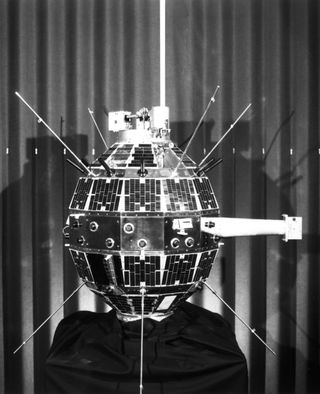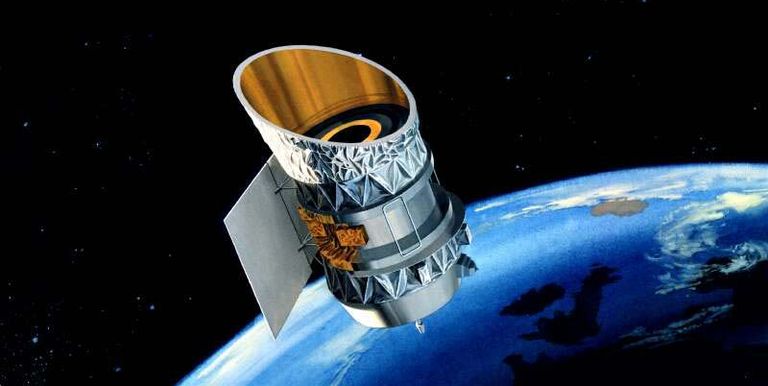
Posted on 01/28/2020 10:20:22 AM PST by Red Badger
What happens if the retired space telescope and former spy satellite crash into each other?
______________________________________________________________
Leo Labs, a venture-based company that monitors satellites in Low Earth Orbit, tweeted yesterday that it was tracking two satellites that will come within 15 to 30 meters of each other January 29, just before 6:40 p.m. EST. The two satellites are IRAS, a decommissioned NASA space telescope, and GGSE-4, a US Naval Research Lab intelligence satellite. They're set to sweep past each other in the skies above Pittsburgh at an altitude of about 559 miles above Earth's surface.
_____________________________________________________________________
LeoLabs, a company that monitors the trajectories of spacecraft in Low Earth Orbit, tweeted Monday afternoon that it was monitoring the close approach of two satellites that are likely to come within meters of each other on Wednesday, January 29. Were they to crash, the collision could send out a sprawling debris field, which could potentially impact other satellites in orbit.
The two satellites, NASA’s IRAS space telescope and the experimental U.S. Naval Research Lab satellite GGSE-4, will swing past each other at 6:39 p.m. EST at an altitude of about 559 miles in the skies above Pittsburgh, Pennsylvania. They’ll be hurtling along their orbit at a relative velocity of about 32,880 miles per hour and could swing within 50 feet of each other.
LeoLabs noted that, at the time of the tweet, the odds of a collision were about 1 in 100 and said the relatively large size of the two spacecraft increased the risk of a collision. “Events like this highlight the need for responsible, timely deorbiting of satellites and space sustainability moving forward,” the company tweeted.
NASA, the Netherlands Agency for Aerosace Programmes, and the U.K.'s Science and Engineering Research Council launched the Infrared Astronomical Satellite (IRAS) from Vandenberg Air Force Base in California on January 25, 1983. IRAS carried three scientific instruments: a survey array, a low resolution spectrometer and a chopped photometric channel.
For 10 months, the space telescope monitored the skies in infrared wavelengths. It discovered six new comets, charted our galaxy’s guts, and uncovered evidence of solid material—an indicator of planetary formation—around the stars Vega and Formalhaut. The 2103-pound telescope was put to pasture on November 21, 1983. image A model with the same design as U.S. Naval Research Lab satellite Poppy 5B. NRO
Meanwhile, the U.S. Naval Reconnaissance Office, the National Security Agency, and the Naval Research Lab launched the other spacecraft, GGSE-4 or POPPY 5b, from Vandenberg in 1967—one of a seven-satellite intelligence mission. Some information about the POPPY program was declassified in 2005. The 187-pound satellite has 59-foot-long gravity gradient booms that reach out into space—an obvious concern given the close distance in which the two satellites are projected to pass. It was decommissioned in 1972.
Scientists and space industry veterans founded LeoLabs in 2016 to better track and monitor the myriad satellites, spacecraft, and debris hurtling through Low Earth Orbit, according to its website. Based out of Menlo Park, California, the company has a worldwide network of phased-array radars that track objects in LEO in high definition.
As we’ve increasingly launched more and more spacecraft into Earth’s orbit, astronomers, engineers, and space industry experts have grown increasingly concerned about the Kessler Effect. Named for NASA space debris expert Don Kessler, the theory suggests a series of collisions between spacecraft in Earth’s orbit could spur a devastating series of chain reactions.
If there were enough impacts, the amount of space junk created would reach a critical mass, blanketing our planet in fog of debris and making it nearly impossible to safely launch spacecraft from Earth.
Former astronaut Ed Lu, who is LeoLabs’ vice president of strategic projects, put a call out to Pittsburgh-area amateur astronomers to train their telescopes on the sky tomorrow night. Needless to say, we’ll all be holding our breath, hoping these two satellites can slide past each other without incident.

A model with the same design as U.S. Naval Research Lab satellite Poppy 5B.
__________________________________________________________

IRAS (13777), the decommissioned space telescope launched in 1983, and GGSE-4 (2828), an experimental US payload launched in 1967.
(IRAS image credit: NASA)
I predict fender bender !
If both are speeding along at close to the same speed, it’ll likely mean a slight change in trajectory, little paint scraping and be gone.
It wont be a head on collison is what I’m saying.
Quark

That’s it!
Sounds like a great job for a US Space Force vehicle.
“What happens if the retired space telescope and former spy satellite crash into each other? “
Well.... the couple will mate and all of a sudden there will be hundreds of baby satellites.
Do satellites have insurance? Would they call Geico if they got hit?
"Salvage 1," starring Andy Griffith.
Regards,
Currently, there are about 5,000 satellites in orbit around Earth, around 2,000 of which are still operational according to the most recent report from the European Space Agency.
And SpaceX, Boeing and now Amazon hope to drastically improve satellite internet, one batch of low-orbiting satellites at a time. The most recent SpaceX launch added 60 satellites to their active fleet, an early fraction of the nearly 12,000 the company plans to set into orbit in the coming months. This is the result of the creation of teledesic by Gates, the money, Boeing, the satellite builder, Craig McCaw, for the devices needed, and the US government for airspace in the early 1990’s.
And someone is worried about two coming close to each other? It’s already a dump up there.
rwood
I'm surprised Space is not the new frontier for environmental activism.
How do we know that they are set for a head on collision ? Maybe this is a glancing pass. It doesn’t say what their speed is ‘relative’ to each other.
I think we all have the coverage — it s on the policy listed as your Ping-Pong risk. Usually offered as part of your pinball machine benefit.
They’ll de-orbit, eventually...
That one I never saw!
Solar furnaces and 3d printers. Don’t throw away stuff that runs tens of thousands per pound to get into space.
There should be an international agreement that all new satellites have a decommissioning jet that will be activated once the equipment is no longer usable and will cause it to burn up in the atmosphere above the Pacific ocean..................
Not without oxygen.
That’s what I said as well. I’m pretty sure that most equatorial revolving satellites orbit in the same direction.
Two reasons:
1. no head on collisions.
2. For achieving orbit, less fuel is used in one direction than the other.
Aw, just send up Phil Swift and some Flex Seal...
Disclaimer: Opinions posted on Free Republic are those of the individual posters and do not necessarily represent the opinion of Free Republic or its management. All materials posted herein are protected by copyright law and the exemption for fair use of copyrighted works.